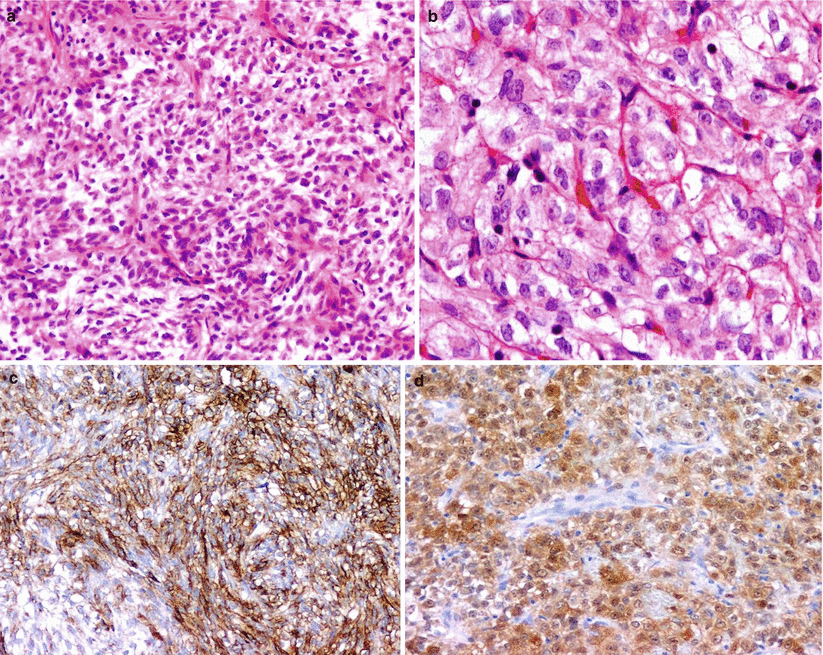Fig. 43.1
Spindle cell oncocytoma. (a) Sagittal T1-weighted gadolinium-enhanced MR image. (b) Coronal T1-weighted gadolinium-enhanced image. An enhancing mass centered in the sella is eroding the upper clivus, with suprasellar extension to the anterior floor of the third ventricle. The pituitary gland is not seen distinct from the mass
43.3 Histopathology
SCO is classified as a WHO Grade I neoplasm.
SCOs are composed of fusiform, mitochondrion-rich spindle cells alternating with areas of epithelioid-like cells that exhibit eosinophilic, granular cytoplasm [7, 8].
SCOs demonstrate immunoreactivity for the S100 protein, vimentin, EMA, Bcl-2, galectin-3, nestin, and TTF-1, as well as the antimitochondrial antibody 113-1 (Fig. 43.2). Conversely, they do not stain for GFAP, follicular-epithelial cytokeratin, neurofilament, synaptophysin, carcinoembryonic antigen, or anterior pituitary hormones [6, 7, 9].
The Ki-67 labeling index may be as high as 20 % in SCOs [8].

Fig. 43.2
Spindle cell oncocytoma. These tumors are characterized by spindle cells arranged in interwoven fascicles (a) intermixed with plump cells with eosinophilic, finely granular cytoplasm consistent with an oncocytic cellular component (b) (H&E stain). The tumor cells are immunoreactive for EMA (c), vimentin, S100 (d), and TTF-1 and are mostly negative for GFAP. The recent observation of TTF-1 expression in normal pituicytes and tumors of the pituitary region—including pituicytomas, granular cell tumors, and spindle cell oncocytoma—raises the possibility that these tumors may represent different variants of a common pathogenetic origin
43.4 Clinical and Surgical Management
SCOs are often mistaken for nonfunctioning pituitary adenomas. They are typically treated via transsphenoidal resection [7, 8].
SCOs are notably characterized by high vascularity and firm consistency, often limiting the degree of safe tumor resection [4, 10].
Only limited anecdotal reports are available pertaining to adjunctive radiation or medical management of SCOs.
References
1.
Roncaroli F, Scheithauer BW. Papillary tumor of the pineal region and spindle cell oncocytoma of the pituitary: new tumor entities in the 2007 WHO Classification. Brain Pathol. 2007;17:314–8.CrossRefPubMed
Stay updated, free articles. Join our Telegram channel

Full access? Get Clinical Tree








